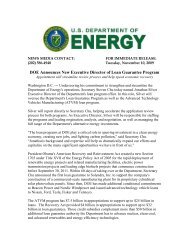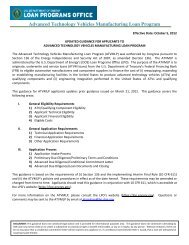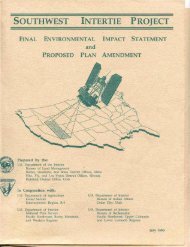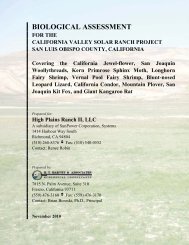Bureau of Land Management's Decision Record and Environmental
Bureau of Land Management's Decision Record and Environmental
Bureau of Land Management's Decision Record and Environmental
You also want an ePaper? Increase the reach of your titles
YUMPU automatically turns print PDFs into web optimized ePapers that Google loves.
Jersey Valley Geothermal Development Project<br />
<strong>Environmental</strong> Assessment: NV063-EAO8-091<br />
3.5 WILDLIFE (INCLUDING THREATENED AND ENDANGERED SPECIES, SPECIAL STATUS<br />
SPECIES AND MIGRATORY BIRDS)<br />
3.5.1 Affected Environment<br />
A biological survey <strong>of</strong> portions <strong>of</strong> the Jersey Valley Unit Area <strong>and</strong> the entire transmission line<br />
corridor was conducted by Great Basin Ecology in May 2008 (GBE 2008). Subsequent to the<br />
May 2008 biological survey, additional areas <strong>of</strong> proposed surface disturbing activities were<br />
identified at the transmission line substation area. A survey <strong>of</strong> this area was conducted on April<br />
22, 2009.<br />
Similar wildlife species are likely to be found within the Jersey Valley Unit Area <strong>and</strong><br />
transmission line corridor. These species include a variety <strong>of</strong> small mammals, raptors, reptiles<br />
<strong>and</strong> insects <strong>and</strong> are identified <strong>and</strong> described below.<br />
Common mammalian species include the black-tailed jackrabbit (Lepus calfornicus), kangaroo<br />
rats (Dipodomys sp.), coyote (Canus latrans), badger (Taxidea taxus), <strong>and</strong> a variety <strong>of</strong> other<br />
small mammals (i.e. mice, voles, ground squirrels, etc) (GBE 2008).<br />
The Jersey Valley Unit Area does not have any known raptor nests nor does it provide suitable<br />
nesting habitat. One previously active prairie falcon nest <strong>and</strong> one previously active burrowing<br />
owl nest exist within 1 mile <strong>of</strong> the proposed transmission corridor <strong>and</strong> will be addressed further<br />
in the Special Status Species Section. No other known raptor nests or suitable habitat exists<br />
within the transmission corridor.<br />
Foraging habitat for raptors such as golden eagle (Aquila chrysaetos), red-tailed hawk (Buteo<br />
jamaicensis), common raven (Corvus corax), prairie falcon (Falco mexicanus), ferruginous hawk<br />
(Buteo regalis), <strong>and</strong> northern harrier (Circus cvaneus) may be found within the Jersey Valley<br />
Unit Area <strong>and</strong> along the transmission line corridor.<br />
A variety <strong>of</strong> reptiles have the potential to occur within the Jersey Valley Unit Area <strong>and</strong><br />
transmission line corridor. Such species include the western whiptail lizard (Cnemidophorus<br />
tigris), leopard lizard (Gambemia wislizenii) <strong>and</strong> western fence lizard (Sceloporus occidentalis).<br />
The Great Basin rattlesnake (Crotalus atrox) is likely to occur in the broken rocks <strong>and</strong> brush<br />
habitats on the east side <strong>of</strong> the Jersey Valley Unit Area.<br />
The BLM identified mule deer (Odocoileus hemionus), bighorn sheep (Ovis canadensis nelsoni)<br />
<strong>and</strong> pronghorn antelope (Antilocapra americana) habitat as potentially occurring within portions<br />
<strong>of</strong> the Jersey Valley Unit Area <strong>and</strong>/or the transmission line corridor, as described below.<br />
Mule deer<br />
Mule deer move between various zones from the forest edges at higher elevations to the desert<br />
floor, depending on the season. While the mule deer occupies almost all types <strong>of</strong> habitat within<br />
its range, it seems to prefer arid, open areas <strong>and</strong> rocky hillsides. Seasonal movements involving<br />
- 43<br />
-







